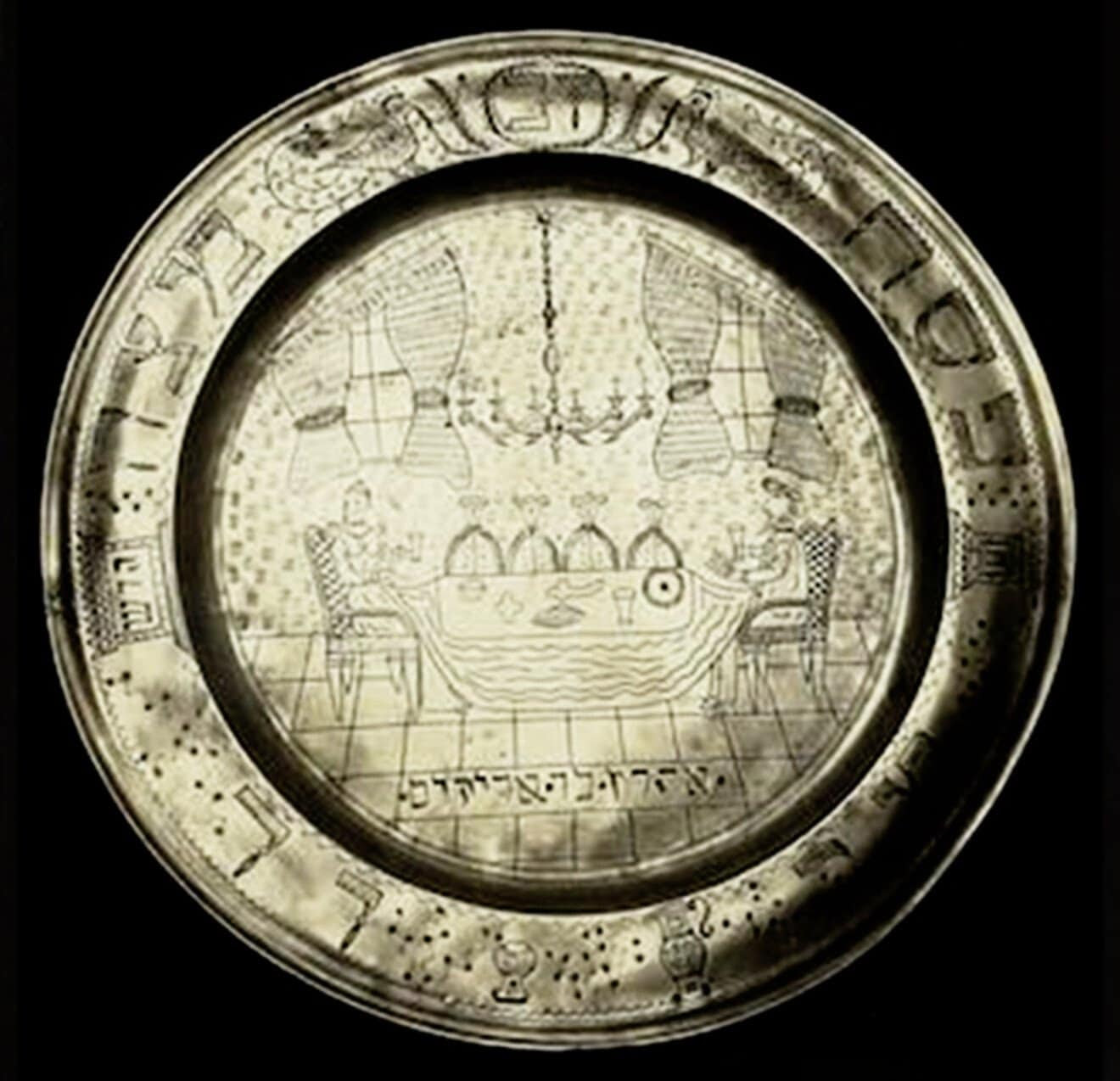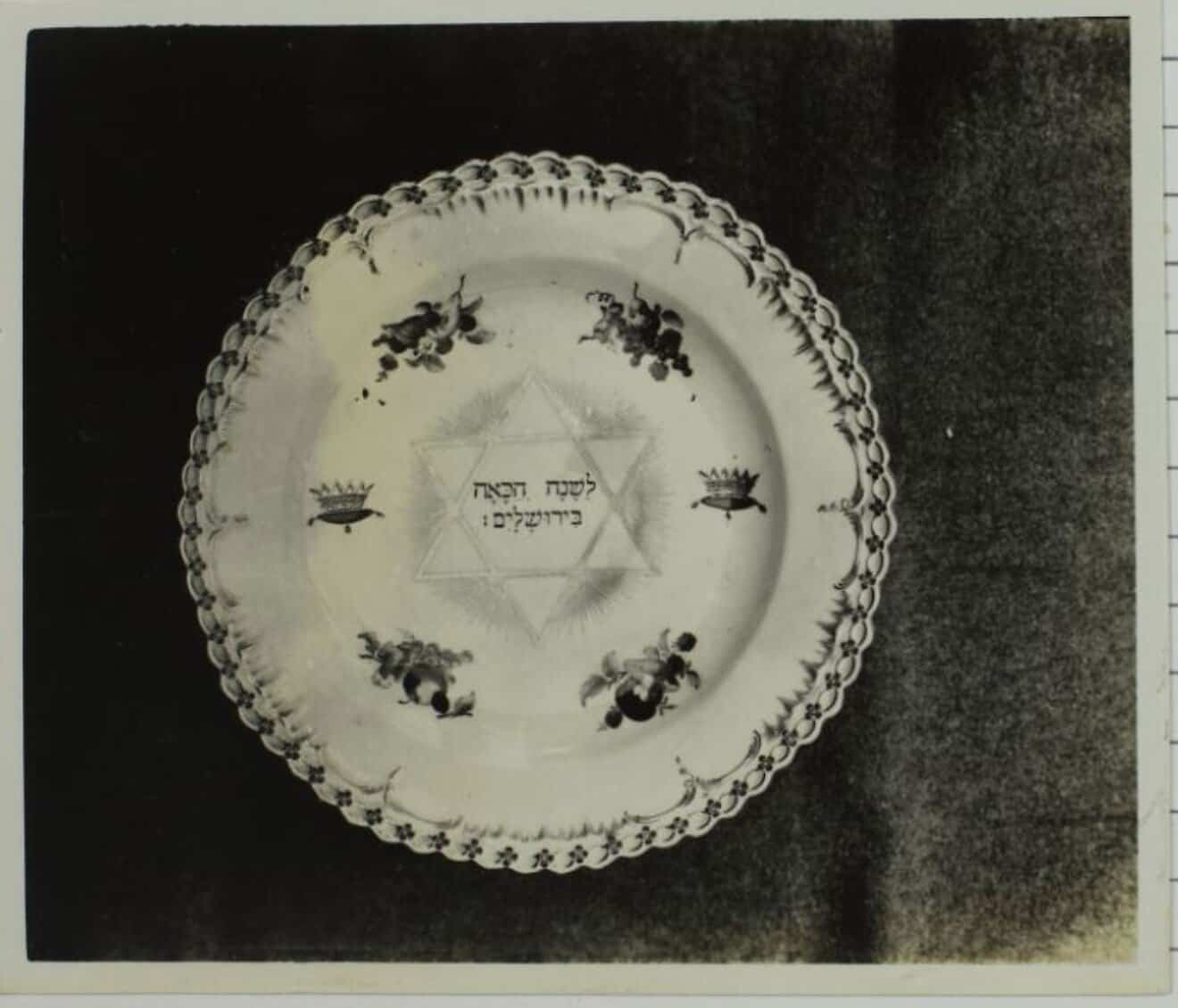The centuries-old seder plates photographed by Theodor Harburger in the 1920s may be the only remnants we have of many Jewish families from Bavaria.
Yochai Ben-Ghedalia
(JNS)
TREUCHTLINGEN, Bavaria—The year is 1928 and a quiet seder is being held in the home of Siegfried Meyer, head of the town’s small Jewish community. The family is gathered around a lavish holiday table, with a magnificent, ornate seder plate at its center—the pride of the family.
About 14 years later, this plate, along with all the Meyer family’s belongings, would be destroyed or taken as part of the Third Reich’s looting and destruction campaign, erasing centuries of Jewish history and folklore.
The Nazis’ rise to power led to the elimination of Jewish communities throughout Germany. However, in many areas, ancient communities had already disappeared due to urbanization and migration.
Even before the Nazi regime, the Association of Bavarian Israelite Communities (Verbandes Bayerischer Israelitischer Gemeinden) initiated a documentation mission, led by art researcher Theodor Harburger, who worked in the region between 1926 and 1932.
Harburger survived the Holocaust and immigrated to Israel, bringing with him his rare collection, which serves as a testament to the lives of German Jewish communities that were plundered and murdered in the Holocaust.
For six years, Harburger traveled across Bavaria, photographing synagogues, private collections of Jewish families, and Jewish cemeteries, with a focus on Judaica.
His photographs were preserved on glass negatives, and the developed images were pasted onto index cards, where he documented in brief what he had captured. At the same time, he meticulously recorded his observations in densely written notes on small pieces of paper.
It is unclear where Harburger received his formal education in art. He mentions several universities where he had studied, including Munich, Geneva and Berlin.
However, his notes, articles and lectures provide comprehensive evidence of his knowledge in art, art history, and Jewish and general history. His writings indicate a deep familiarity with Hebrew and Jewish sources, while his lectures and essays in Germany, and later in Israel, reflect a profound Jewish awareness.
A year after his project ended, the Nazis rose to power. Many synagogues in Germany were burned during Kristallnacht in 1938, their contents lost, with much of their Judaica confiscated years before the systematic extermination of the Jews.
Harburger’s documentation project offers us a final glimpse into a disappearing world. More than 70% of the objects he photographed and described were destroyed or lost during the Holocaust, but his records and photographs provide an accurate overview of 300 years of Jewish life in Bavaria’s rural communities.
In recent years, his images have been used extensively to identify and locate Judaica looted by the Nazis. In recent years, the Harburger mission was the focus of a research project, led by the late Bernhard Purin, director of the Jewish Museum Munich.
Immediately after the Nazis came to power, Harburger left Germany, immigrating to Israel and taking his documentation with him. To make a living, he and his wife, Meta (Miriam), opened a guesthouse in Tiberias. Eventually, like many other German-Jewish families, they settled in the northern Israeli town of Nahariya, where he died in 1949.
The couple had no children, and the archive was deposited in the Central Archives for the History of the Jewish People (CAHJP), now part of the National Library of Israel, where the fragile and heavy glass negatives are preserved. Since then, Harburger’s photographs have been displayed in numerous exhibitions, primarily in Germany.
Most of the Judaica items documented by Harburger were located in synagogues, but the seder plates he photographed were found in Jewish homes. Harburger recorded dozens of seder plates in private residences across Bavaria, some passed down over generations and others collected by notable private collectors.
Seder plates, then as now, served as the centerpiece of the Passover seder table. They provide crucial insights into the holiday’s central traditions for German Jews in the 18th and 19th centuries. Their design evolved over the centuries, yet their aesthetics and beauty remain extraordinary.
Unlike modern seder plates, which include designated indentations or even small bowls for the symbolic foods—such as the shank bone, egg, and charoset relish—whose placement varies by tradition, early South German Jewish seder plates lacked such compartments.
They also did not indicate specific placements for the foods, but rather emphasized the images and texts, as can be seen in these examples of exceptional seder plates from the Harburger collection, all of which were photographed in the 1920s and 1930s.
Seder plates have no clear halachic origin, certainly no guidelines regarding the shape or motifs that can appear within them. Nevertheless, the plates we are familiar with are round. The circular arrangement and the differences in height within the platter allow for various texts to be incorporated, some related to the Haggadah text, others with more personal dedications.
For instance, a seder plate from 1807, owned by Max Zeidel of Munich, is relatively simple in design. Made of pewter, like most of the plates documented by Harburger, its inscriptions and decorations were crafted using a repoussé technique.
The outer rim features the order of the seder—Kadesh, Urchatz (hand-washing), etc.—which, due to space limitations, are arranged in two concentric circles. An inner inscription cites the owners, referring to both husband and wife, and the year of creation: “Itzik, Gütel, made in the year 5567 [1807].” At the plate’s center is a lamb, the only non-text or floral motif.
The lamb represents the month of Nisan, the Jewish people as a lone sheep among 70 wolves that are the nations of the world, but primarily, the lamb as the Paschal sacrifice.
The Central Archives for the History of the Jewish People was unable to find out what happened to Zeidel.
The engraving on this plate is richer in detail. In addition to numerous geometric and floral decorations, it includes many interesting texts, which may have been created in different stages.
For example, while the raised part of this seder plate states that it was created in the year 5674 (1754), the dedication indicating ownership by the late Meir Bar Shlomo Segal of Orebach (which Harburger identified as Oderbach) and his wife, Tamara, daughter of Rabbi Aharon Shalit, features a date from the following year, 1755, suggesting the dedication was added later.
The order of the seder appears on the inside of the raised part of the bowl, while the song “Chad Gadya” is illustrated on the outer side. The father is depicted sitting near the table, smoking a pipe, and he purchases the goat not for “two zuzim” but for the local equivalent: two pshitum, simple, low-value coins.
The “water” in the song takes the form of a contemporary well, and the Angel of Death has a rather Luciferian appearance.
Depicting human figures on an item used in a Jewish religious context was controversial, but the need to express the figure of the Holy One, Blessed be He (or: “Heaven,” as appears in the accompanying inscription) posed an even greater challenge. The solution was a kind of sun, from which six trumpets (shofarot) issue, with the addition of a hand holding a sword that extends towards the Angel of Death.
The circular arrangement emphasizes the cyclicality expressed in the song, and a lamb, not a goat, is at the plate’s center. To make the allusion absolutely clear, two letters appear below it: Kuf and Peh (ק”פ), for korban pesach, the Passover sacrifice.
As a lamb pursued by wolves, Dr. Wilhelm Feibelmann did not succeed in escaping Germany. On Jan. 19, 1942, his wife died. Ten days later, he committed suicide by taking sleeping pills. He was 81 years old. We do not know what happened to the plate, or whether it remained to tell the family story.

The town of Treuchtlingen is an example of the importance of Harburger’s expedition. For centuries, it was one of the main Jewish communities in Bavaria, and in 1837, about 20% of the population was Jewish.
However, by 1925, three years before the expedition’s visit, there were only about 100 Jews left, and Harburger diligently documented everything he found. This seder plate was used in a private home, but the motifs on it are more similar to items found in synagogues, such as Torah scrolls and Torah ark curtains.
The seder symbols appear again on the raised part, but the decoration on the inside is not of a lamb, but of two lions with a crown above them. Each of the lions is holding something in its paw. Harburger identified one rounded object as matzah, and the other as maror.
In the center, within a floral decoration, appear three letters: ה ע ט (heh, ayin, tet), the meaning of which Harburger had difficulty deciphering, as did we. However, the notes that Harburger wrote, in which he documented his visit to Treuchtlingen, point us toward a solution.
His notes indicate that the back of the plate is marked with the date of its creation, 1719, which allows us to suggest that the inscription in the center is a distortion of the Hebrew calendar equivalent, תע”ט (5470), probably made by a Christian artist who was not familiar with the Hebrew alphabet and mistook ת (taf) for ה (heh).
From the Jewish press in Germany, we learn that Siegfried Meyer, who headed the community for 22 years, died in 1937, leaving behind his wife, Mina. In the mayor’s report to the Nazi authorities after Kristallnacht, she appears as one of the last Jews in the city. The fate of his wife is unknown. As in the case of Feibelmann, it is not clear where the plate is today.

The plate from the private collection of Dr. Benedikt Nussbaum, which originally belonged to a man named Aharon bar Elyakim, focuses on the Passover seder.
Plates like this one were already about 200 years old at the time of Harburger’s research, and are of great value to those who possess them. Its raised section bears the three words that, according to tradition, every seder participant must utter to fulfil their obligation: pesach, matzah and maror.
The inner area of the plate features a visual depiction of a hall where the seder takes place. Details of the room are clearly illustrated—flooring, curtained windows, and the Shabbat menorah familiar from Jewish homes in Germany.
At either end of the table sit the host and his wife, with four additional, less prominently depicted figures seated along its sides. The host holds a cup of wine, and on the table, one can make out other recognizable items, including matzah.
Unlike his three sisters who died in a concentration camp, Nussbaum immigrated to Israel and was buried in Binyamina in 1946. Did he manage to take the seder plate with him? We don’t know.
Seder plates have always reflected the period in which they were created and the people who chose to keep them in their homes.
These negatives—sometimes the only surviving trace of entire Jewish Bavarian families—form a vital link in the generational chain and stand as a poignant reminder of the rich, full lives that were lost.

This article originally appeared in The Librarians, the official online publication of the National Library of Israel dedicated to Jewish, Israeli, and Middle Eastern history, heritage and culture.
Featured Image: Seder plate from the private collection of Dr. Benedikt Nussbaum, Munich. The Theodor Harburger Archive, the Central Archives for the History of the Jewish People at the National Library of Israel.


